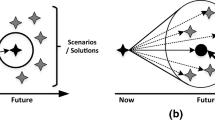Abstract
Member selection is an important decision making problem in the formation of emergency medical teams. It involves selecting an optimal combination from a reasonable number of doctors, nurses and emergency medical technicians. Selecting suitable members for a medical emergency team (MET) will facilitate the effectiveness of emergency medical service (EMS). Essentially, investigations on EMS could offer models which increase the efficiency of proper matching and earn time to save lives. The existing methods for member selection pay much attention to the individual information to measure the individual performance of members, while few studies focus on the collaborative information to measure the collaborative performance between members. This paper aims to propose a two-stage method for member selection of an MET. In the first stage, knowledge rules are proposed to identify the valid candidates quickly. In the second stage, the individual information of members, the collaborative information between members, and the response time of EMS are all considered to build a three-objective 0-1 programming model. Due to its intractability, the model is solved by a non-dominated sorting genetic algorithm II. Liberia, now suffering the Ebola virus, is used as a backdrop for this study. A practical example followed by a computational simulation experiment is used to illustrate the applicability and the effectiveness of the proposed method.



Similar content being viewed by others
References
Bravo G, Squazzoni F, Boero R (2012) Trust and partner selection in social networks: an experimentally grounded model. Soc Netw 34:481–492
Deb K, Pratap A, Agrawal S, Meyarivan T (2002) A fast and elitist multi-objective genetic algorithm: NSGA-II. IEEE T Evolut Comput 6:182–197
DeVita MA, Bellomo R, Hillman K, Kellum J, Rotondi A, Teres D (2006) Findings of the first consensus conference on medical emergency teams. Crit Care Med 34:2463–2478
D’Souza GC, Colarelli SM (2010) Team member selection decisions for virtual versus face-to-face teams. Comput Hum Behav 26:630–635
Duart A, Marti R (2007) Tabu search and GRASP for the maximum diversity search. Discret Optim 178:71–84
Feng B, Fan Z, Ma J (2010a) A method for partner selection of co-development alliances using individual and collaborative utilities. Int J Prod Econ 124:159–170
Feng B, Jiang Z, Fan Z, Fu N (2010b) A method for member selection of cross-functional teams using the individual and collaborative performances. Eur J Oper Res 203:652–661
Friese CR, Manojlovich M (2012) Nurse-physician relationships in ambulatory oncology settings. J Nurs Scholarsh 44:258–265
Ghosh BA (1996) Computational aspects of the maximum diversity problem. Oper Res Lett 19:175–181
Gu Y, Fan J, Tang G, Zhong J (2013) Maximum latency scheduling problem on two-person cooperative games. J Comb Optim 26:71–81
Holland JM (1975) Adaptation in natural and artificial systems. The University of Michigan, Ann Arbor, MI
Hourihan F, Bishop G, Hillman K, Daffurn K, Lee A (1995) The medical emergency team: a new strategy to identify and intervene in high-risk patients. Clin Intensive Care 6:269–272
Hwang CL, Yoon K (1981) Multiple attribute decision making: methods and applications. Springer, Berlin
Levy M, Kaplanski G (2015) Portfolio selection in a two-regime world. Eur J Oper Res 242:514–524
Li Z, Zhou M (2004) Elementary siphons of Petri Nets and their application to deadlock prevention in flexible manufacturing systems. IEEE T Syst Man Cybern A 34:38–51
Li Z, Wu N, Zhou M (2012) Deadlock control of automated manufacturing systems based on Petri nets: a literature review. IEEE T Syst Man Cybern C 42:437–462
McDermid EJ, Manlove DF (2010) Keeping partners together: algorithmic results for the hospitals/residents problem with couples. J Comb Optim 19:279–303
Ponte PR, Gross AH, Milliman-Richard YJ, Lacey K (2010) Interdisciplinary teamwork and collaboration: an essential element of a positive practice environment. Annu Rev Nurs Res 28:159–189
Sok YL, Chiang S, Zhou WT, Lau TC (2014) Inter-professional simulation-based education program: a promising approach for changing stereotypes and improving attitudes toward nurse-physician collaboration. Appl Nurs Res 27:258–260
Turban E, Aronson JE (1998) Decision support systems and intelligent systems, 5th edn. Prentice Hall, Upper Saddle River, NY
Zhong L, Luo S, Wu L, Xu L, Yang J, Tang G (2014) A two-stage approach for surgery scheduling. J Comb Optim 27:545–556
Acknowledgments
This work was partially supported by the National Natural Science Foundation of China under Grants 71101114, 71473188, 71401131, 71403158 and 61374068, China Postdoctoral Science Foundation under Grant 2012M511979, the Fundamental Research Funds for the Central Universities under Grants BDY251412, and the Science and Technology Development Fund, MSAR, under Grant 066/2013/A2.
Author information
Authors and Affiliations
Corresponding author
Rights and permissions
About this article
Cite this article
Chen, X., Fan, Z., Li, Z. et al. A two-stage method for member selection of emergency medical service. J Comb Optim 30, 871–891 (2015). https://doi.org/10.1007/s10878-015-9856-z
Published:
Issue Date:
DOI: https://doi.org/10.1007/s10878-015-9856-z




